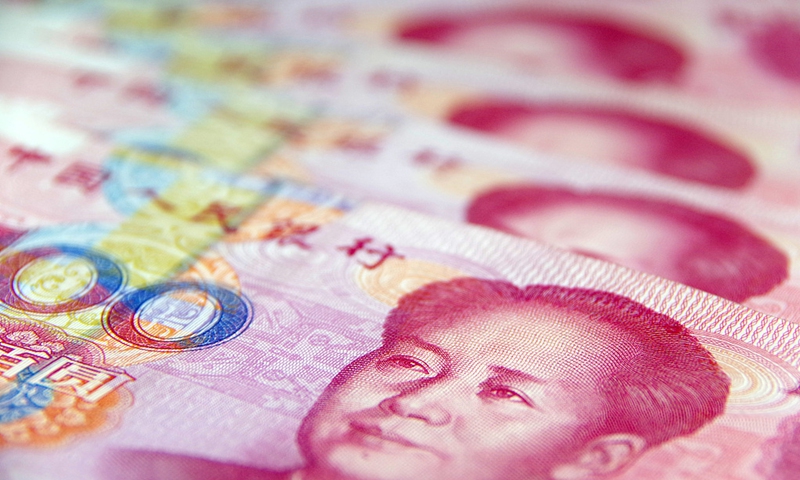
RMB Photo:VCG
In 2022, the US Federal Reserve aggressively raised interest rates and shrank its balance sheet, kicking off the fastest and steepest monetary tightening cycle in 40 years. Although the Chinese yuan exchange rate has undergone some adjustment and volatility, it has smoothly transitioned to two-way fluctuation now.
In 2023, the spillover effects of Fed's tightening monetary policy are expected to continue. Deepening the market-oriented reform of the exchange rate and maintaining the flexibility of the exchange rate will secure China's high-quality development and high-level opening-up against external shocks.
Chinese yuan in 2022 underwent the fastest and deepest adjustment since the major reform of the country's foreign exchange formation system in 1994. The Chinese yuan against the US dollar fell more than 13 percent in eight months - from 6.3 in March to 7.3 in November.
The maximum amplitude of the central parity rate of the yuan exchange rate was equal to 73.2 percent of the average maximum amplitude of the central parity rate of other seven reserve currencies, including the US dollar, euro, yen, pound, franc, Canadian dollar and Australian dollar.
In the wide-range two-way fluctuation of Chinese yuan, China's foreign economic sector has shown growing resilience.
First, the accumulative surplus of foreign exchanges settlement by all Chinese lenders during March-November period reached $60.1 billion.
Second, the leverage adjustment function of the exchange rate is in full play. In 2022, the main body of China's foreign exchange market will become more rational. Especially from September to October, when the yuan fell below 7 against the greenback, investors did not rush to buy foreign exchanges, but instead used their own foreign exchanges for external payments.
Third, the international balance of payment has maintained an autonomic balance, which was not impacted by increase in short-term net capital outflow.
It is expected there will be three possible scenarios for the Fed's trajectory of tightening in 2023. First, Fed will likely increase its tolerance for economic recession due to the decline in potential economic output this year. The monetary tightening may last longer than expectations, and the US dollar is likely to usher in a second phase of rise. Under the condition that other conditions remain unchanged, the yuan exchange rate will continue two-way fluctuations.
The second scenario is that at this stage, Fed is overemphasizing the benefits of monetary tightening, and the central bank may make another mistake, as excessive tightening will lead to a deep recession across the US economy.
Under the combination impact of high inflation and high unemployment, there is a high probability that the Fed will cut interest rates slowly in late 2023, and the trend of the dollar will be strong first and then weak through the year.
As the Chinese economy is more deeply integrated into economic and financial globalization than it was during the 2008 international financial crisis, the spillover impact of the Fed's monetary tightening on China will evolve into shock, and the yuan exchange rate will come under rising pressure.
The third scenario is that the Fed's excessive tightening may also lead to the bursting of the US assets bubble, leading to a deep economic recession like a financial crisis, and a rapid decline in inflation or even deflation. In 2023, the Fed may cut interest rates sharply, and the dollar will initially strengthen due to risk aversion, and then fall sharply. Under such circumstances, China will encounter the double impact of finance and trade, and the yuan will be under greater pressure.
However, in 2023, the rise and fall of yuan will not depend on the strength of the US dollar or the interest rate difference between China and the US, but on China's economic fundamentals. The Central Economic Work Conference held in December 2022 emphasized that in 2023, China must focus on stabilizing growth, employment, and prices. The three major indicators of growth, employment, and inflation will be an important reference for accurately judging the strength of China's economic fundamentals. With the optimization of pandemic responses and relaxed real estate regulation, the accelerated restart of the economy, domestic and foreign investors are mostly optimistic about the prospects for China's economic recovery and the growing value of the yuan.
This is a favorable condition for the strengthening of the yuan exchange rate trend in 2023. All parties should, on the basis of strengthening macroeconomic situation analysis and cross-border capital flow monitoring and early warning system, do a good job in scenario analysis, stress testing, and formulate response plans.
China should continue to enhance the autonomy of monetary policy and support finance to better serve the real economy. China should continue to reduce its reliance on administrative intervention and promote the establishment of a new development pattern for increase dual circulation. And, China should continue to promote balance of payments and macroeconomic stability to better safeguard national economic security.
The author is BOC International's global chief economist and a former official at the State Administration of Foreign Exchange. bizopinion@globaltimes.com.cn
